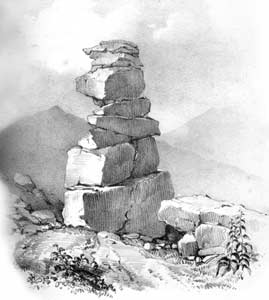






"Cairn" is a loose term for a pile of stones, usually marking an ancient burial place. A "tor" is a natural granite outcropping on the moor, exposed by years of weathering. Granite bedrock lies under the moor, keeping water from draining away, so that the ground remains saturated. "…with a thousand candle-power Swan and Edison right here in front of the hall door." Thomas Alva Edison (1847-1931) and Joseph Swan (1838-1914), as well as other inventors, worked simultaneously on designs for an incandescent light bulb. Swan patented his design 10 years earlier than Edison. Edison, savvier at marketing than Swan, dominated the British and American markets until he was finally forced by the courts to merge his British operation with Swan's. Fitting the Victorian idea of a stereotypical American, Sir Henry turns to technology to fix the gloomy, menacing atmosphere of Baskerville Hall. Unfortunately, Sir Henry's straightforward character and positive attitude go hand-in-hand with a certain naïveté and an inability to comprehend things beyond his limited experience. …crenellated, and pierced with many loopholes. A "crenellated" tower has battlements for archers to shelter behind. "Loopholes" are small openings for surveillance or shooting. Both are relics of Baskerville Hall's medieval past. A dull light shone through heavy mullioned windows…. "Mullioned" windows are common in Gothic architecture, where the "mullion," or vertical divider between windows, is usually made of stone. …and heavily raftered with huge balks of age-blackened oak. "Balks" are large, crude beams. …behind the high iron dogs…. Fireplace "dogs" are stands used for hanging cooking pots at the fire. A dim line of ancestors, in every variety of dress, from the Elizabethan knight to the buck of the Regency… Between 1811 and 1820, the future King George IV ruled as Regent for his father, George III, who suffered from periodic insanity. The Regency was known as a hedonistic and dissolute time. The young "buck" would have been dressed in flamboyant clothing, with curls and a wide-brimmed hat. | ||||
Copyright ©
2006 Stanford University. All rights reserved. Stanford, CA 94305, (650)723-2300
l Terms
of Use
